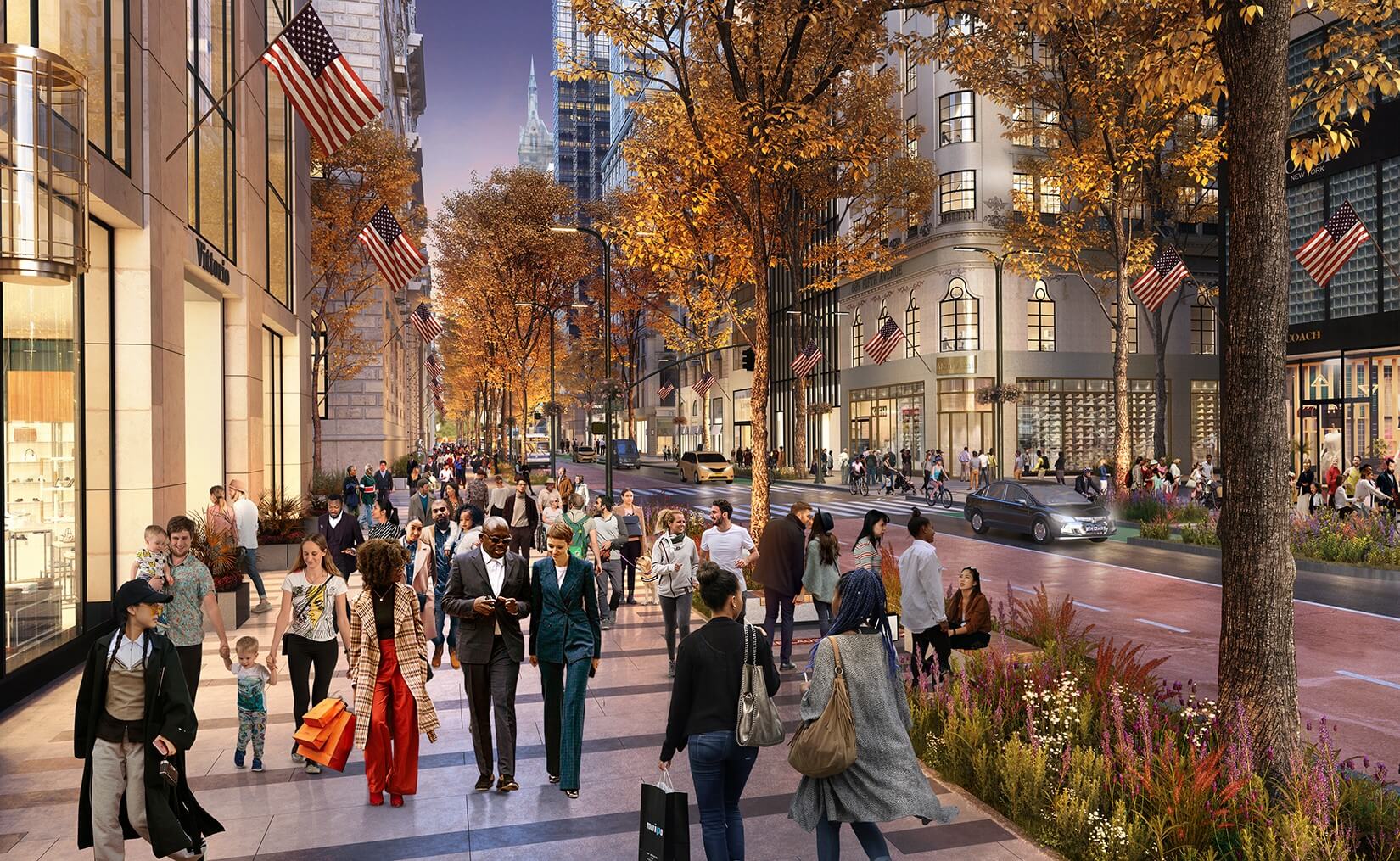Although New York City has worked for years to build bike lanes, improve dangerous crossings, and add pedestrian plazas to busy intersections, the massive success of outdoor dining—particularly restaurants’ curbside sheds—truly underscored what progressive architects and planners have been saying for years: city roadways should prioritize people, not private vehicles.
The latest design intervention in this vein targets one of Manhattan’s busiest thoroughfares. On December 18, Mayor Eric Adams announced that Fifth Avenue spanning from Bryant Park at 42nd Street uptown to Central Park at 59th Street will be redesigned to better accommodate pedestrians, bicyclists, and mass transit. Although plans to remake Fifth Avenue have been in the works for years, the announcement seems to be intended to stoke interest in Mayor and Governor Kathy Hochul’s New New York plan, released last week. Among its 40 recommendations, the visioning document outlined ideas to remake Midtown from a commercial center depopulated by the shift to remote work into a 24/7 neighborhood.

“Fifth Avenue is an iconic corridor and an engine of our Midtown economy. But it is also an unmissable opportunity to show the city and the country how world-class public space can help create vibrant central business districts,” Mayor Adams said in a press release. “New York isn’t coming back, New York is back. But New Yorkers don’t sit on our hands—we will continue to bring everyone to the table, come up with innovative ideas together, and make our city safer, fairer, and more prosperous.”
One especially busy section of the avenue closed to cars for the holiday season. This year the New York City Department of Transportation (DOT) debuted an Open Street (the city’s term for streets closed to vehicles at select times) on Fifth Avenue from 48th to 57th streets for three weekends in December. The agency also closed off the area around Rockefeller Center and Radio City Music Hall through the holiday season so visitors can pack in like sardines to see the 900-pound, Daniel Libeskind–designed 3D star studded with three million Swarovski crystals (the pine tree underneath is pretty nice, too).
The forthcoming Fifth Avenue plan will be a mega, year round version of the current Open Street. Among the additions outlined by Adams are plans to expand sidewalks, add trees and greenery, improve lighting, and redesign traffic patterns to speed up buses moving at a glacial pace through Manhattan. Renderings, shared by the city to give an idea of what is yet to come, depict the existing two bus lanes but show one lane for cars, down from the current three. The hope is these plans will not only make the avenue more pleasant for pedestrians, but also contribute to the success of businesses along the corridor.
“After two years studying this corridor, we are thrilled to work with Mayor Adams and his team on reimagining Fifth Avenue for the future,” Fifth Avenue Association Board Chair Ed Hogan said in a release. “Fifth Avenue has been an economic powerhouse for the city and a leader in retail, tourism, and office space. However, there hasn’t been a public investment in over 100 years. The sidewalks can’t accommodate the crowds, and the streets are overly congested. Open Streets has shown how improving the pedestrian experience can draw more New Yorkers and tourists to this iconic global corridor.”
Early next year, the New York City Economic Development Corporation (NYCEDC) and DOT will select an architect for the project. After that, the visioning and construction plans are slated for completion in two years. The plan will be partially funded by a public-private partnership spearheaded by the Fifth Avenue Association, the Grand Central Partnership, the Bryant Park Association, and the Central Park Conservancy, among other area groups.











